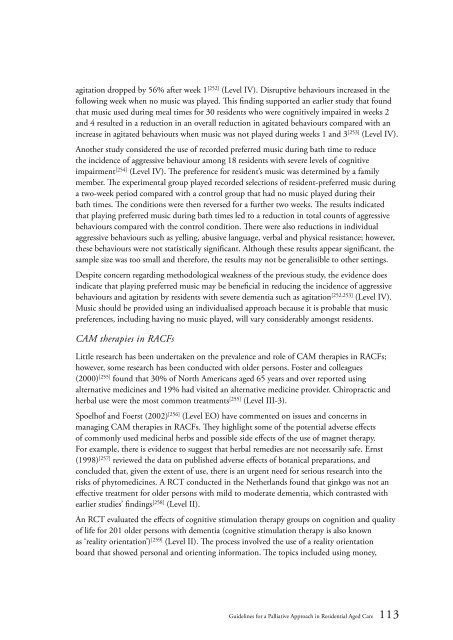Guidelines for a Palliative Approach in Residential Aged Care
Guidelines for a Palliative Approach in Residential Aged Care
Guidelines for a Palliative Approach in Residential Aged Care
You also want an ePaper? Increase the reach of your titles
YUMPU automatically turns print PDFs into web optimized ePapers that Google loves.
agitation dropped by 56% after week 1 [252] (Level IV). Disruptive behaviours <strong>in</strong>creased <strong>in</strong> the<br />
follow<strong>in</strong>g week when no music was played. This f<strong>in</strong>d<strong>in</strong>g supported an earlier study that found<br />
that music used dur<strong>in</strong>g meal times <strong>for</strong> 30 residents who were cognitively impaired <strong>in</strong> weeks 2<br />
and 4 resulted <strong>in</strong> a reduction <strong>in</strong> an overall reduction <strong>in</strong> agitated behaviours compared with an<br />
<strong>in</strong>crease <strong>in</strong> agitated behaviours when music was not played dur<strong>in</strong>g weeks 1 and 3 [253] (Level IV).<br />
Another study considered the use of recorded preferred music dur<strong>in</strong>g bath time to reduce<br />
the <strong>in</strong>cidence of aggressive behaviour among 18 residents with severe levels of cognitive<br />
impairment [254] (Level IV). The preference <strong>for</strong> resident’s music was determ<strong>in</strong>ed by a family<br />
member. The experimental group played recorded selections of resident-preferred music dur<strong>in</strong>g<br />
a two-week period compared with a control group that had no music played dur<strong>in</strong>g their<br />
bath times. The conditions were then reversed <strong>for</strong> a further two weeks. The results <strong>in</strong>dicated<br />
that play<strong>in</strong>g preferred music dur<strong>in</strong>g bath times led to a reduction <strong>in</strong> total counts of aggressive<br />
behaviours compared with the control condition. There were also reductions <strong>in</strong> <strong>in</strong>dividual<br />
aggressive behaviours such as yell<strong>in</strong>g, abusive language, verbal and physical resistance; however,<br />
these behaviours were not statistically significant. Although these results appear significant, the<br />
sample size was too small and there<strong>for</strong>e, the results may not be generalisible to other sett<strong>in</strong>gs.<br />
Despite concern regard<strong>in</strong>g methodological weakness of the previous study, the evidence does<br />
<strong>in</strong>dicate that play<strong>in</strong>g preferred music may be beneficial <strong>in</strong> reduc<strong>in</strong>g the <strong>in</strong>cidence of aggressive<br />
behaviours and agitation by residents with severe dementia such as agitation [252,253] (Level IV).<br />
Music should be provided us<strong>in</strong>g an <strong>in</strong>dividualised approach because it is probable that music<br />
preferences, <strong>in</strong>clud<strong>in</strong>g hav<strong>in</strong>g no music played, will vary considerably amongst residents.<br />
CAM therapies <strong>in</strong> RACFs<br />
Little research has been undertaken on the prevalence and role of CAM therapies <strong>in</strong> RACFs;<br />
however, some research has been conducted with older persons. Foster and colleagues<br />
(2000) [255] found that 30% of North Americans aged 65 years and over reported us<strong>in</strong>g<br />
alternative medic<strong>in</strong>es and 19% had visited an alternative medic<strong>in</strong>e provider. Chiropractic and<br />
herbal use were the most common treatments [255] (Level III-3).<br />
Spoelhof and Foerst (2002) [256] (Level EO) have commented on issues and concerns <strong>in</strong><br />
manag<strong>in</strong>g CAM therapies <strong>in</strong> RACFs. They highlight some of the potential adverse effects<br />
of commonly used medic<strong>in</strong>al herbs and possible side effects of the use of magnet therapy.<br />
For example, there is evidence to suggest that herbal remedies are not necessarily safe. Ernst<br />
(1998) [257] reviewed the data on published adverse effects of botanical preparations, and<br />
concluded that, given the extent of use, there is an urgent need <strong>for</strong> serious research <strong>in</strong>to the<br />
risks of phytomedic<strong>in</strong>es. A RCT conducted <strong>in</strong> the Netherlands found that g<strong>in</strong>kgo was not an<br />
effective treatment <strong>for</strong> older persons with mild to moderate dementia, which contrasted with<br />
earlier studies’ f<strong>in</strong>d<strong>in</strong>gs [258] (Level II).<br />
An RCT evaluated the effects of cognitive stimulation therapy groups on cognition and quality<br />
of life <strong>for</strong> 201 older persons with dementia (cognitive stimulation therapy is also known<br />
as ‘reality orientation’) [259] (Level II). The process <strong>in</strong>volved the use of a reality orientation<br />
board that showed personal and orient<strong>in</strong>g <strong>in</strong><strong>for</strong>mation. The topics <strong>in</strong>cluded us<strong>in</strong>g money,<br />
<strong>Guidel<strong>in</strong>es</strong> <strong>for</strong> a <strong>Palliative</strong> <strong>Approach</strong> <strong>in</strong> <strong>Residential</strong> <strong>Aged</strong> <strong>Care</strong> 113
















